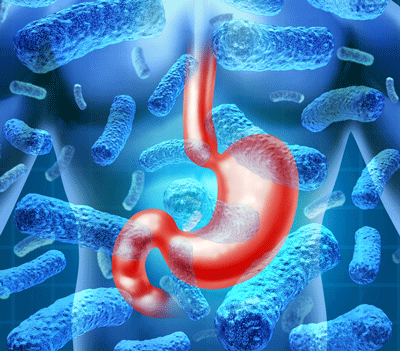Now that we know the answer to "What are Probiotics?", we need to understand the basic functions of those superb organisms that we share our lives with. This article discusses 4 basic functions of probiotics in our bodies.

1) Interaction with other microrganisms inhabiting the gut, including virus and yeast.
The mechanism of action of probiotic bacteria towards the other bacteria inhabiting the gut is not well understood. It is thought that feeding probiotics could alters the intestinal population as determined by fecal enumeration. However, whilst in individuals where the number of already present enteric bacteria is low (i.e.after an antibiotic therapy) the probiotic
supplementation is able to increase the number of fecal counts of lactic bacteria, it seems difficult to increase the presence of the total population of lactic acid bacteria in healthy subjects. Some studies suggest that a replacement effect takes place; in other words, while the total lactic counts remain stable, the fed strain(s) replace some of the previously present lactic strains. However, the real mechanisms by which probiotic bacteria influence the microflora are not elucidated. It has been proposed that production of acetic acid and lactic acid may restrict the growth of potential pathogenic and putrefactive bacteria, but conclusive proofs are lacking.
On the contrary, a worthy of well-conducted trials has showed the in vivo efficacy against rotavirus and antibiotic-associated diarrhoea. It is possible to conclude that, while the efficacy has been demonstrated in aquite acceptable way, the mechanism underlying this efficacy are scarcely understood.
2) Interaction with the intestinal epithelia, including the gut associated lymphoid tissue (GALT)
We can divide the available data into two subsets of information:
- adhesion to epithelia
- interaction with the GALT
The first item has been thoroughly investigated in vitro to select strains capable to persist into the human gut, which is an hostile, moving environment with the tendency to expel its content. Some of the mechanisms used by lactic acid bacteria have been elucidated, the relevance of mucus has been discovered and some genes involved in the adhesion phenomena have been cloned and sequenced. Strains showing an high level of adhesion in vitro have been shown to persist into the gut. Curiously, the vice-versa was not checked and we only a few data on the in vivo persistence of strains which adhere poorly in vitro. Therefore the relevance of the adhesion assays in vitro has been recently questioned.
In addition, adhering probiotic bacteria seem to outcompete pathogens in the colonisation process, thus protecting the host from infections. These observations, however, are base mainly on in vitro experiments.
Interactions of probiotic bacteria with GALT have been discovered after several workers have noticed in vivo the ability of some selected strains to regulate some immunological functions. Investigations in this field have been widened and now a complex picture of the immune regulating properties of strains of lactic bacteria is available. A careful selection and characterisation of the strains have to be done, in order to avoid the use of strains able to elicit a pro-inflammatory response from the host. This is a quite new and relevant point to be raised from the safety point of view. On the other hand an exciting field of research and application has been opened by the studies which have shown that interaction of probiotic bacteria with the host immune functions could be used to reduce problems of allergy in pediatric age. While the mechanisms are not fully understood, the clinical observations seem more than promising.
3) Interaction with the nutrients contained in the diet
Adding probiotic to your diet can actually help in the production of B-complex vitamins. According to S.K. Dah and Beth Ley in the book "Health Benefits of Probiotics," good bacteria creates the B vitamins biotin, riboflavin, thiamine, pantothenic acid and pyridoxine within the intestinal tract. Natasha Trenev notes in the book "Probiotics: Nature's Internal Healers," that the vitamin B12 is specifically manufacturered by bacteria and aids in the creation of red blood cells. Foods like cheddar cheese, kefir, sour cream and yogurt are beneficial sources of vitamin B-producing bacteria, Trenev says.
Good bacterial strains help to facilitate maximum absorportion and utilization of nutrients, according to Trenev. For example, Lactobacillus bulgaricus and Streptococcus thermophilus are especially beneficial as active transite bacteria helpful in uptaking nutrients, Trenev reports. Although there are several live and active cultures, consuming specific strains like L. bulgaricus and S. thermphilus can procure optimal probiotic effects.
4. Other health claims include
Perhaps one of the most notable functions of probiotics is their ability to regulate digestion and normalize the intestinal tract, Dah and Ley state. A 2006 study by Marine Elli et al., entitled "Survival of Yogurt Bacteria in the Human Gut" and published in "Applied and Enviornmental Microbiology" found that the bacteria Lactobacilli, S. thermophilus and Bifidobacterium effectively survived through the intestinal pathways and expelled through regulated bowel movements. This illustrates the probiotic's digestion-enhancing qualities in helping to break down food within the intestines while regulating the bowels.
The production of Short Chain fatty Acid (SCFA) is one of the best known physiological effects produced by lactobacilli and bifidobacteria. This activity is easily verified in human newborns, where the intestinal flora is formed, when compared to the adult microflora composition, by a reduced number of bacterial groups. The number of these bacteria into the gut is quite homogeneous in different healthy individuals as regards bifidobacteria, but it is widely variable for lactobacilli.
In health,
Nakita

Disclaimer: The above information is provided for informational purposes only and is not intended to replace the advice of your physician.


